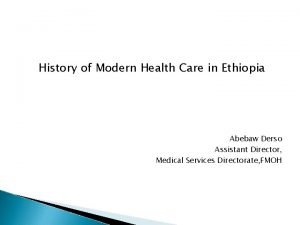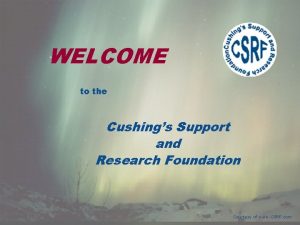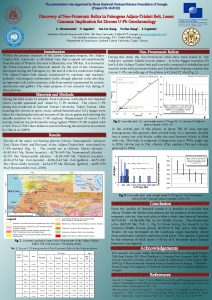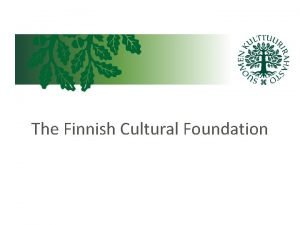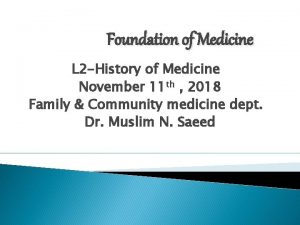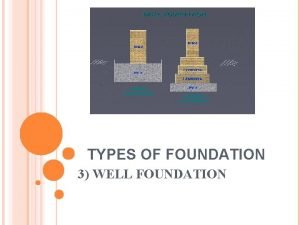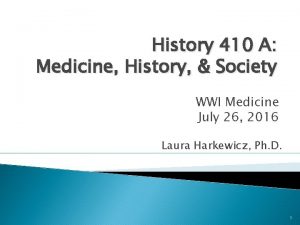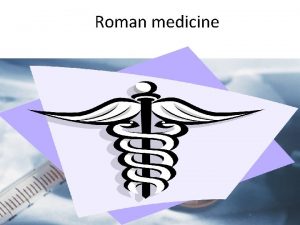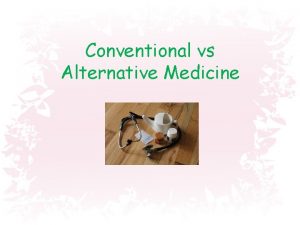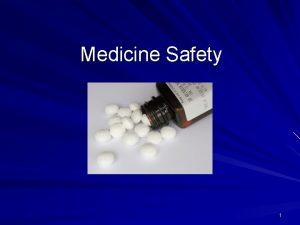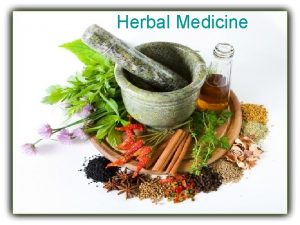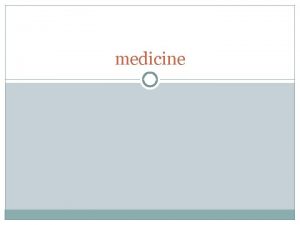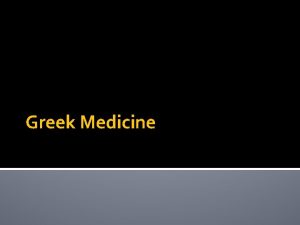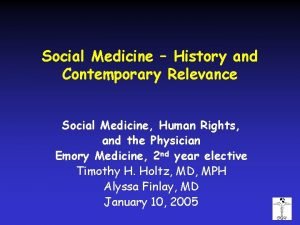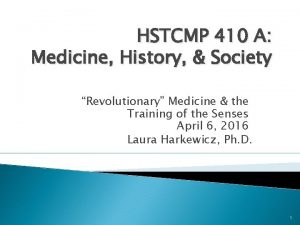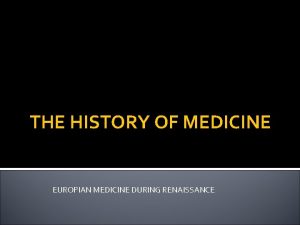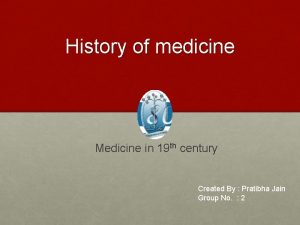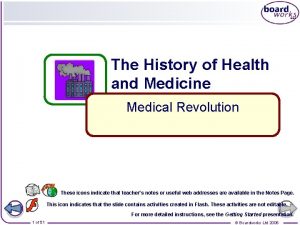Foundation of Medicine L 1 History of Medicine























- Slides: 23

Foundation of Medicine L 1 -History of Medicine November 5 th, 2018 Family & Community medicine dept. Dr. Muslim N. Saeed

PRE- ISLAMIC ERA The primary objective of medicines is to prevent and cure disease, or to use medicines that mitigate the progressive, devastating, or disabling aspect of disease. From the dawn of humanity, healers try to alleviate illnesses and treat wounds and fractures. Archaeological findings suggested that the earliest humans believed in spirit, and supernatural forces. There were special individuals who were able to contact the spirit world and seek their guidance. They call upon the spirit to heal the sick man.

Many authors suggested that those individuals represented the most ancient doctors. However, many civilizations obtain a good knowledge in surgery and in the use of herbs, animal parts, and minerals in the treatment of diseases.

Medicine in Ancient Mesopotamia (land between Tigris and Euphrates) was the area of the first civilization. The origin of civilization was traced to a group of people living in the southern Mesopotamia called Sumerians 3500 B. C, the true civilization is said to have begun around 3100 B. C. with the development of cuneiform writing.

After cuneiform development, they became the dominant system of writing in Mesopotamia for over 2000 years. Most of the information available to modern scholars come from these cuneiform. Most of the cuneiform tablets, which deal with medical issues, were found in the library of Ashurbanipal, the last great king of Assyria. This library, which was housed in the king’s place at Nineveh, was burned by invaders; around 20000 clay tablets were baked by the great fire.

Many drugs were mentioned in tablets in Mesopotamia cuneiform Most of these drugs were plant extract, resins and spices. Dressing of wounds followed 3 steps technique including washing, bandaging and making plasters prepared from plant extracts, animal fat and alkali, which when heated yields soap with antiseptic activity. The primary health center for healthcare was the patient's own house, and the family members acting as care givers.

Other important places for religious healing were nearby rivers. The Mesopotamians believed that the rivers had the power to drive out evil, substances and forces that were causing the disease. Surgery was also performed in Mesopotamia. It included opening of abscesses, tooth extraction, pushing of urethral stone to the bladder, removing of dead tissues, treatment of glaucoma suturing of wounds …etc.

However, the code of Hammurabi 1700 B. C. stated that the physician who perform surgery is responsible for surgical errors and failure. However, if a person of high status died as a result of surgery, the surgeon risked having his hand cut off, while if a slave died from surgical operation, the surgeon only had to pay to replace the slave.

Medicine in Ancient Egyptian medicine was also dependent on myth and legend, and the treatment was carried out by both magicians and medicine men. However, ancient Egyptian papyri inform us that the medical practice was highly advanced for its time. It included surgery, setting of bones and extensive sets of pharmacopoeia including herbal therapy, the nature and characteristics of herbs and their efficacy and uses in the treatment.

Egyptian classified injuries to 3 types, treatable, contestable and untreatable. The surgeons were quickly dealing with the treatable injury, surgical tools included knives, hooks, drills, forceps, scales, spoons, saws, etc.

Mummification reflected an advanced knowledge in surgical tools anatomy, chemistry, and preservation. Many arts of industry prosthetics such as artificial toes and eyeballs were also used. They were usually used for decorative purposes. Archaeological finding also showed signs of forced tooth extraction and tooth replacement.

Herbs play a major part in Egyptian medicine. Some of herbal medicines were used by ancient Egyptian doctors: Acacia (Acacia nilotica)- internal bleeding, also used to treat skin diseases. Garlic (Allium sativa) - gives vitality, soothes flatulence and aids digestion, mild laxative, shrinks hemorrhoids, rids body of "spirits" Aloe vera - worms, relieves headaches, soothes chest pains, burns, ulcers and for skin disease and allergies

Balsam Apple (Malus sylvestris) or Apple of Jerusalem - laxative, skin allergies, soothes headaches, gums and teeth, for asthma, liver stimulant, weak digestion Belladonna - pain reliever; - reduces fevers, soothes gums, soothes epilepsy. Caraway (Carum carvi; Umbelliferae) soothes flatulence, digestive, breath freshener Colchicum (Citrullus colocynthus) – soothes rheumatism, reduces swelling

Henna (Lawsomia inermis) , stops diarrhea, close open wounds (and used as a dye) Honey was widely used, a natural antibiotic and used to dress wounds, as castor oil. Mustard (Sinapis alba) - induces vomiting, relieves chest pain Onion (Allium cepa) - diuretic, induces perspiration, prevents colds, soothes sciatica, relieves pains and other cardiovascular problems

Parsley (Apium petroselinum) - diuretic Mint (Mentha piperita) -soothes flatulence, aids digestion, stops vomiting, and breathes freshener Sesame (Sesamum indicum) - soothes asthma Tamarind (Tamarindus indica) - laxative Tumeric (Curcumae longa) - closes open wounds (also was used to dye skin and cloth)

Medicine in Ancient China Traditional Chinese medicine has developed over a period of at least 5000 years. The Chinese have divided the world into 5 elements; these include fire, earth, water, metal and wood, these 5 elements (which are each related to body organs and colors), and the meridians. Chinese doctors manipulated the herbal drugs and minerals to adjust energy of these forces in the body, they also developed a special system of physiology, as vital organs and meridians became the principle of acupuncture.

Medicine in Ancient Greeks also believed in supernatural source of illness. They turned to the Gods for cure like God Appollo and God Asclepios. Places which were called Asclepeia were built for sick people where they encourage sleeping as it was believed that during the sleep they would be visited by Asclepios or his two daughters. However, the Greeks were practicing medicine 1000 years before the birth of Christ. Surgery was done and herbs were applied. There were even specialists including gynecologists who specialized in childbirth and diseases of women.

Hippocrates The first doctors in the modern sense appeared in Ancient Greek was Hippocrates was considered the father of medicine in Greek. He was the son of a physician. He separated medicine from divine, and he believed that checking symptoms, giving diagnoses and administering treatment should be separated from the rituals of the priests.

The medicine of the Greek depended on the four humors, which represented the metabolic agents of the four elements in the human body. The right balance and their purity are essential to maintaining health. The Four Humors and the elements are as follows: blood-air, phlegm-water, yellow bile-fire, and black bile-earth. The Greek also had an extensive knowledge of herbs and herbal properties. The common herbs used in Ancient Greek are: anise, cassia, cucumber, cumin,

The usual method of herbal treatment in Greek medicine is to use medicines whose natures are contrary or complementary to the nature of the disorder to bring the body back into balance. The Greeks also practicing surgery using many tools including forceps, scalpels, tooth-extraction forceps and catheters. There were even syringes for drawing pus from wounds. The Greeks knew fracture fixation and how to prevent infection.

Medicine in Ancient Rome The Romans incorporated both a scientific and mythological approach to medicine and healthcare. They adopted much of the Greeks' scientific data concerning medicine. Primarily, Hippocrates gave the Romans a holistic look at medicine and the treatment of illnesses and diseases. Ancient Roman medicine was a combination of physical techniques using various tools and holistic medicine using rituals and religious belief systems. Ancient Romans believed that diseases were brought on by the disfavor of the gods. Many of the Roman gods were believed to have healing powers, but one in particular played a prominent role in ancient medicine. Aesculapius, the god of healing, was the prominent that governed the Roman medical practice.

The doctors in ancient Rome were not nearly as highly regarded as the doctors in Greece. The profession itself, was considered a low social position. Women also performed an important service to the field of medicine. As a tradition lasted for centuries, midwives delivered babies and became experts in women's health. Mineral, plants, liquid or animal part were used in treatment of diseases. Roman surgeons were highly advanced and skilled professionals with a good knowledge of anatomy. They carried out different types of surgical operations such as hernia, tumors removing, trepanation (a form of brain surgery using a drill to induce a hole in the skull to relieve pressure and cure headaches), cataract surgery and some cosmetic operations such as removing of excess skin or tissues were also practiced. Some of surgical tools used by Roman surgeon include Scalpels, hooks or probes, bone drills, Metal forceps, Catheters, bone saw, vaginal speculum and Bone levers.

 Pad foundation
Pad foundation Composition of urine
Composition of urine Jonathan roberts first hospital pharmacist
Jonathan roberts first hospital pharmacist Modern medicine in ethiopia
Modern medicine in ethiopia History also history physical
History also history physical Wpf navigationwindow
Wpf navigationwindow Windows communication foundation wcf monitoring
Windows communication foundation wcf monitoring Dr. mason moore
Dr. mason moore Extensive reading foundation
Extensive reading foundation Cushing's research and support foundation
Cushing's research and support foundation Foundation stage 2
Foundation stage 2 New orleans police foundation
New orleans police foundation Define nursing?
Define nursing? Trigonometry gcse questions
Trigonometry gcse questions Chijnaya foundation
Chijnaya foundation Wise work and travel
Wise work and travel Stif competencies
Stif competencies Shota rustaveli national science foundation
Shota rustaveli national science foundation Combined science gcse grades
Combined science gcse grades Microsoft foundation class library
Microsoft foundation class library Lfpa warner
Lfpa warner Foundation for worldwide international student exchange
Foundation for worldwide international student exchange Finnish cultural foundation
Finnish cultural foundation Clara abbott scholarship login
Clara abbott scholarship login



